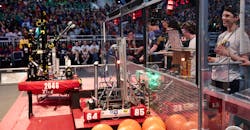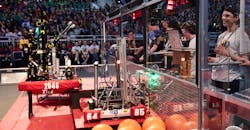Guest blog today.
I'm turning the place over to Brian Cieslak, K9WIS,who writes about his personal experiences with FIRST, an organization that runs robotic competitions for kids (see the figure). I answered Brian’s CQ on 20 meters, and in the ensuing QSO, I mentioned that I was just back from Renesas’ DevCon in Orange County, where Renesas had turned over an entire lunch session, packed with hundreds of engineers, to Dean Kamen, so that Kamen could encourage attendees to participate in the program. (Wikipedia says: “FIRST (For Inspiration and Recognition of Science and Technology) is an organization founded by inventor Dean Kamen in 1989 to develop ways to inspire students in engineering and technology fields. The organization is the foundation for the FIRST Robotics Competition, FIRST LEGO League, Junior FIRST LEGO League, and FIRST Tech Challenge competitions.”)
1. The FIRST robotics competition includes many competition levels (courtesy of FIRST/ Argenis Apolinario).
I remarked to Brian that I admired the program as Kamen explained it, but I had some questions, which I’ll bring up in a later blog. Brian told me that he had been a FIRST volunteer for years, that he was extremely positive about the program and that he had written an article for the American Radio Relay League (ARRL) Website, “The Ham Radio Spirit Lives — in Robots?,”
Then he sent me a email, with more about his personal experience in the program than we had covered on-air. I have his permission to repeat it here:
“I got involved in FIRST back in 2005. Rockwell sent out an email asking if anyone would be interested in talking to a group of kids at the high school down the street with a programming project. They needed to learn C.
“It was the school I graduated from back in 1973 so I volunteered, made contact with the instructor. When I arrived after work that day I was basically tackled by 3 highly motivated kids interested in learning programming. I asked them what their project was and the escorted me to the backroom where a 120 pound robot stood. they showed me a video that illustrated the game rules and from that point on I was hooked.
“The kids learn about the game on the first weekend in January and have 6 weeks to design, build and test the robot. If they miss the drop dead date, their season is over. Its amazing to see those kids stick around until 10 at night to work on the robot and give up their Saturdays too. If the robot is complete (defined loosely) it is shipped to their first competition. I gone through several generations of kids since then. I am proud do say most of my programmers have gone on to engineering careers.
“One recently joined me here at Rockwell. Other kids have returned after graduation to mentor the team. I am sort of a mentors mentor these days.
“There are several flavors of FIRST.
There is Lego League for kids in grades 4- 8. I like getting kids from this program on my teams because there robots missions are all autonomous.
“The Lego Mindstorm kit is the kit used to build a robot to fulfill a specific mission. But is not just robots. The kids have to do a presentation of some theme, environment, energy, medicine, space exploration, that is chosen by FIRST at the beginning of the season
“Then there is FTC a cross between LEGO league and FRC. The robots are tele-operated to play a game. FTC uses the same controller as FTC but instead of Lego's its more like an erector set. FTC is a low cost solution. A team can get set up for around $1000.
“Then there is FRC, the big robots, 125 lbs if unleashed fury.both tele-operated and autonomous. Currently using the National Instruments cRIO programmable controller, wireless Ethernet. FRC is expensive. It probably costs as much to field an FRC team as a football team. So kids have to approach sponsors for funding.
“FRC is more than just robots, its more like Junior Achievement on steroids.
Some team members may be interested in marketing and not robots so they take on the challenge of PR and raising funds. Others are into logistics, making all the arrangements for travel or demonstrations. There is an entrepreneurs award to reward those kids.
“There is a web page competition, so kids who are interested in that facet can have an opportunity to support the team.
“There is an animation competition, sponsored by Autodesk who provides teams with 3ds max as well as all their other software like Autocad and inventor.
“There a design contests using inventor. There is an innovation award.
“And the most coveted award the Chairman's for teams using innovation in community service.
“I could go on and on.The cool part is as a programming mentor I spend 6 weeks working with the kids to give them confidence to try ideas. Some work some don't but its all learning experience. After the build cycle I let the kids take over maintaining the robot code, tweeking at competitions. I just standby to make sure they don't kill anyone..hi hi .They have never disappointed me and I let them know it.
“I work with high school kids at a public school. Here is a story about the kids on my team. During the whole season I never met a parent. Even when we had an open house for parents to see what the kids were up to they didn't show. Our team did quite well that year, even went to the National Championships in Atlanta. Three mentors and two teachers accompanied a team of 8 kids. We were worried about what kind of trouble we were going to have to deal with. But those kids were so engrossed in doing well at the competition that they were very professional during the whole trip.
“The finished 23rd out of 600 robots in the competition. Not bad, we had a team banquet later that spring. Guess what? no parents showed. Finally I sat down with one of the teachers to ask him about it. He said a lot of these kids come from single parent homes.Mom or dad is home watching little brother or little sister. Chances are that for the three months I am working with the kids I am the only male figure in there lives..Very scarey since I don't have any kids, also very cool.
“I can go on forever with what FIRST has done for these kids, But I can also go on talking about what those kids have done for me.
“One last note. I was one of the first employees at Rockwell to get involved with FIRST. I had pay all my own expenses and take vacation time to travel with the team. Today, 8 years later, Rockwell has adopted FIRST as their STEM school activity of choice and is a big sponsor, funding any team that has a Rockwell employee as mentor. And now they even cover travel and lodging expenses for mentor employees.”
About the Author
Don Tuite Blog
Don Tuite covers Analog and Power issues for Electronic Design’s magazine and website. He has a BSEE and an M.S in Technical Communication, and has worked for companies in aerospace, broadcasting, test equipment, semiconductors, publishing, and media relations, focusing on developing insights that link technology, business, and communications. Don is also a ham radio operator (NR7X), private pilot, and motorcycle rider, and he’s not half bad on the 5-string banjo.

